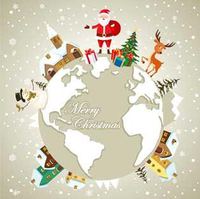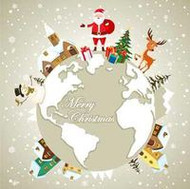Christmas Traditions Around the World
23rd Jan 2016

Although Christmas traditions are completely different from culture to culture, the
atmosphere that brings the most joyous holiday is the same everywhere. In all parts of the
world, for those who celebrate it, Christmas is a day of love, gratitude and family gatherings.
Here are some of the Christmas traditions around the world.
UNITED KINGDOM - Merry Christmas
Preparations for Christmas begin with food, of course, sending Christmas cards, decorating
the house and preparing gifts. On Christmas Eve, the stocking are putted on the edges of
the bed or on the chimney, where there Santa leaves gifts. Christmas begins with the
opening of gifts and lunch after which a televised speech follows the royal family. In the
afternoon are visited neighbors and relatives. During Christmas dinner custom is serving
Christmas pudding most often plum (cakes pastry stuffed with a variety of dried fruit) in
which there is a "treasure".
The United Kingdom was the first country that for Christmas decoration began to use
mistletoe. Mistletoe garlands adorned the doors and homes, and anyone who is found
beneath the cornice can be kissed or should kiss someone. In Covent Garden Santa Claus
(Father Christmas) lights the lamps, and on the famous Trafalgar Square there is a beautiful
tree and, of course, mistletoe.
FRANCE - Joyeux Noel
On Christmas Eve, children leave their shoes by the fireplace in order to Santa Claus (Pere
Noel) brought gifts. In addition to shoes, on Christmas morning, sweets, fruit and small toys
are also hanging from the tree. In the north of France, children are bestowing on December
6th, the day of St. Nicholas instead of Christmas. Adults are each donating to the New Year.
Church bells on are playing Christmas songs. In the square, near the cathedral, are showing
the birth of Christ.
Almost every home has a nursery, around which actually spins the whole Christmas
celebration. Nursery contains clay figurines called Santos, which in December are sold at
Christmas fairs in Marseille and Aix. Figures except that depict St. Family and pastors often
appear and craftsmen, fishermen, farmers.
The French are making chocolate cake in the shape of the trunk that is called La Buche de
Noel. The same trunk, to previous time of period, was burned to drive away the ghosts that
light. The cake is served with other foods during Le Reveillon, very late dinner after midnight
Mass on Christmas Eve. The main dish varies on regional culinary traditions, and in Alsace
served goose, in Burgundy turkey with chestnuts, while Parisians celebrate with oysters and
pate from goose or duck liver (pat de foie gras). After dinner, when the family goes to bed,
leave the food on the table in case of a Virgin Mary.
The Christmas tree is a product of the French, the first Christmas tree lit up in Alsace in the
17th century. In 1840, the Duchess of Orleans conveys the Christmas tree in Paris.
ITALY - Buon Natale
Christmas season lasts for three weeks and starts 8 days before Christmas, known as the
Novena (Novena). A week before Christmas, the children go from house to house dressed
as shepherds and singing Christmas songs for what they are getting money. The real
celebrations begin fasting for 24 hours before Christmas Eve with a meal dominated
panettone - cake / bread slot-like shape.
After sunset shot from a cannon at Castel S. Angelo in Rome marks the beginning of the
holiday season. In the 21 hours in the church begins Holy Mass. After the mass approaches
the holiday meal with family starts. On Christmas Day at noon, the Pope gives blessing to all
who gather at the Vatican square.
Christmas Eve is called Cenon and served a traditional dish of eels. Christmas dinner
consists of Torttelini in Brodo, soup with stuffed pasta and Capone, boiled or baked rooster.
Gifts are drawn from the so-called urns of fate in which there is always one gift for each.
While in other parts of Italy, the children their gifts can only open on January 6, the
Epiphany. According to tradition, brings gifts ugly witch called La Befana on the handle of
her broom. La Befana is scheduled to visit the newborn Jesus, but she was late and erratic
since then, leaving gifts in every house for children in the case that Jesus is there. Comes
down to the chimney and leaves gifts to good children in shoes and stockings and naughty
coal.
FINLAND
Hyvaa Joulua! As in many countries, one of the main features of the Christmas is the
Christmas tree. Decorate the Christmas Eve rows of fruit, paper flags, tinsel and candles.
Clean the whole house, and a lot of time is spent in the kitchen in the preparation of various
dishes. When everything is taken care of, be sure to go to the steam bath before preparing
the Christmas dinner. Food is served between five and seven, and gifts are exchanged
before or after a meal. Also, throughout Finland, especially in rural areas, residents in the
yard birds leave crumbs and they are not having dinner while birds do not eat their meal.
Christmas day begins at six o'clock, when people go to church and remind us that this is a
time of love and family gatherings. It is interesting that on Christmas Day people go to the
cemetery to light candles in memory of the dead.
GREECE
Greeks celebrate Christmas on December 25. One of the most important symbols of
Christmas in Greece is St. Nicholas, patron saint of sailors. Witnesses say he saved the
ships that were sinking, and therefore now each ship carries its icon. On Christmas Eve, the
boys with drums and triangle are going from house to house and sing songs. Exchange for
dried fruit, almonds or gifts. Fasting forty days before Christmas, and on Christmas Day they
are preparing fat dishes. In Greece, you will rarely find a Christmas tree adorned, but any
home decorated with basil wrapped around a small wooden cross hanging above the
wooden containers with holy water. On the day of Saint Basil, the first of January, they
exchanged gifts, and are known for custom of giving gifts to hospitals and orphans.
RUSSIA - Pozdravlyayu with prazdnikom Rozhdestva
In Russia, Christmas is replaced with celebration of winter. However, traditional Russian
Christmas is celebrated praying as much as 39 days, until January 6, then starts the 12-
course dinner in honor of the 12 apostles - fish, beet soup or borscht, cabbage stuffed with
millet, cooked dried fruit, etc.
On Christmas songs are sung and people gather in churches that are decorated with a
Christmas tree - Yelka and flowers and colorful bulbs. Christmas dinner usually consists of
goose and pig.
Crucian carp is a traditional Christmas figure who distributes gifts to children. Her name
means' grandmother and the legend say that she refused to visit Jesus with the sage due to
cold weather. However, she regretted it and went after him with a full basket of gifts. She
never found Jesus, therefore, visited every house and gives good children toys.
They believe that gifts give the Sjeguroška or snow women and Santa Claus, who is called
Daddy; it does not follow the reindeer, but the girl (flakes) and a boy (New Year). On that day
children eat black bread, which is located in the hanging socks, telling poems and sing
Christmas songs.
However, the real Christmas according to the Julian calendar, takes place on January 7, and
announces him the Morning Star. Russians celebrate this holiday with family, in peace and
quiet. In Russia, 25 December is a normal working day, is celebrated on 31 December,
when the streets raise decorated pine trees, often celebrated outdoors.
SWEDEN
Early in the morning on December 13th, the day of Santa Lucia, girls wear formal white
dresses and headpieces of evergreen wreaths, to which are attached to the candles. Then
they wake up the parents and give them bread and coffee. This custom dates back to the
fourth century and symbolizes the return of the star. Residents of Sweden kite tree two days
before Christmas, and on January 25, go to church, which is completely decorated with
candles. Swedes like any other people today believe in Santa Claus or Tomte Swedes as it
is called, however, the old legend says that brings gifts Christmas goat - Julbock - goat that
was allegedly used the Tor (old god) for transport.
JAPAN
Beside that only one percent of people in Japan celebrate Christmas, those who worship
practiced by many well-known traditions. In Japanese Shinn Omedeto means "Merry
Christmas". Most of them decorate a Christmas tree Temari with balls that are handmade,
and a Buddhist monk becomes Santa Claus leaving presents for children in the house.
CHINA
In China, a very popular tradition is decorating the Christmas tree ornaments that children
themselves make. The decorations are mostly in the form of paper chains, flowers and
lanterns. Santa Claus, Dun Che Lao Ren, or in translation "Christmas Old Man", bring the
children new toys or clothes. Those who are not religious or do not celebrate Christmas, in
this period are happy for the Spring Festival.

